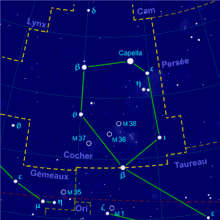Magnitude 3.69 | Orbital period 972 days | |
 | ||
Similar Epsilon Aurigae, Beta Aurigae, Theta Aurigae, Zeta Geminorum, Epsilon Carinae | ||
Zeta Aurigae (ζ Aur, ζ Aurigae) is the Bayer designation for a binary star system in the northern constellation of Auriga. It has the traditional names Haedus and Sadatoni. Based upon parallax measurements made during the Hipparcos mission, this system is approximately 790 light-years (240 parsecs) distant from the Earth. It has a combined apparent visual magnitude of 3.75, which is bright enough to be seen with the naked eye.
This is an eclipsing binary system with the orbital plane being oriented close to the line of sight from the Earth; the inclination of this system is estimated as 87.0°. As a result, an eclipse of one star by the other occurs during each orbit, causing the magnitude to decrease to +3.99. The pair have an orbital period of 972 days (2.66 years) and an eccentricity of 0.4. The primary component has been categorized as a K-type bright giant or supergiant star. Its companion is a B-type main sequence star of stellar classification B5 V or B7 V.
Etymology
It has the traditional names Haedus (also Hoedus) and Sadatoni (rarely Saclateni). It is one of the two haedi (kids) of the she-goat Capella, the other being Haedus II, Eta Aurigae. The name Sadatoni is from the Arabic الساعد الثاني as-sācid aθ-θānī "the second arm (of the charioteer)". The rare traditional name Azaleh is shared (in the form Hassaleh) with Iota Aurigae.
In Chinese, 柱 (Zhù), meaning Pillars, refers to an asterism consisting of ζ Aurigae, ε Aurigae, η Aurigae, υ Aurigae, ν Aurigae, τ Aurigae, χ Aurigae and 26 Aurigae. Consequently, ζ Aurigae itself is known as 柱二 (Zhù èr, English: the Second Star of Pillars.)
